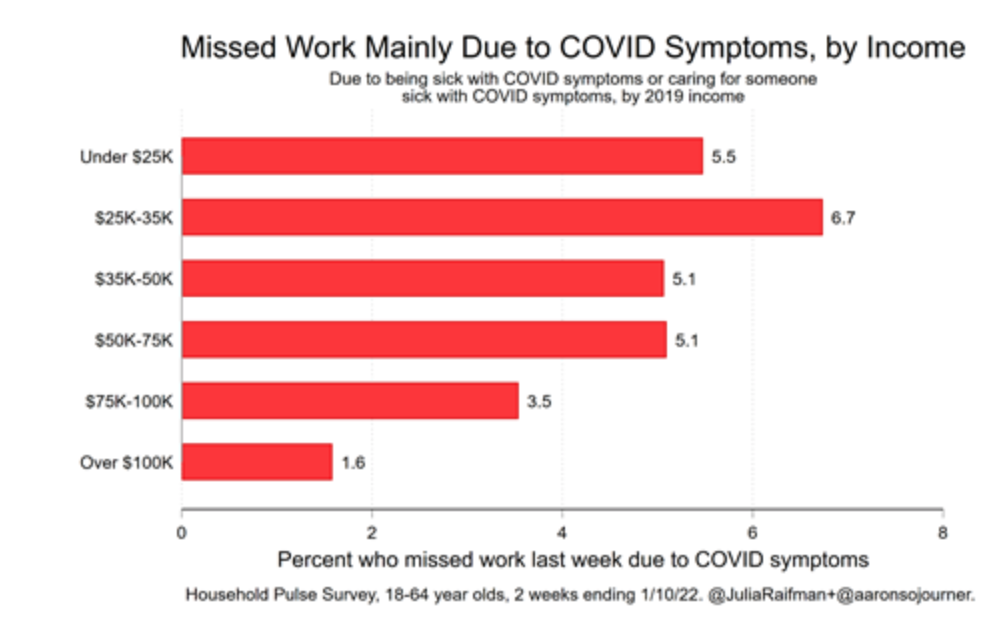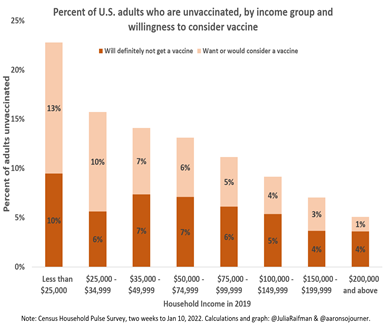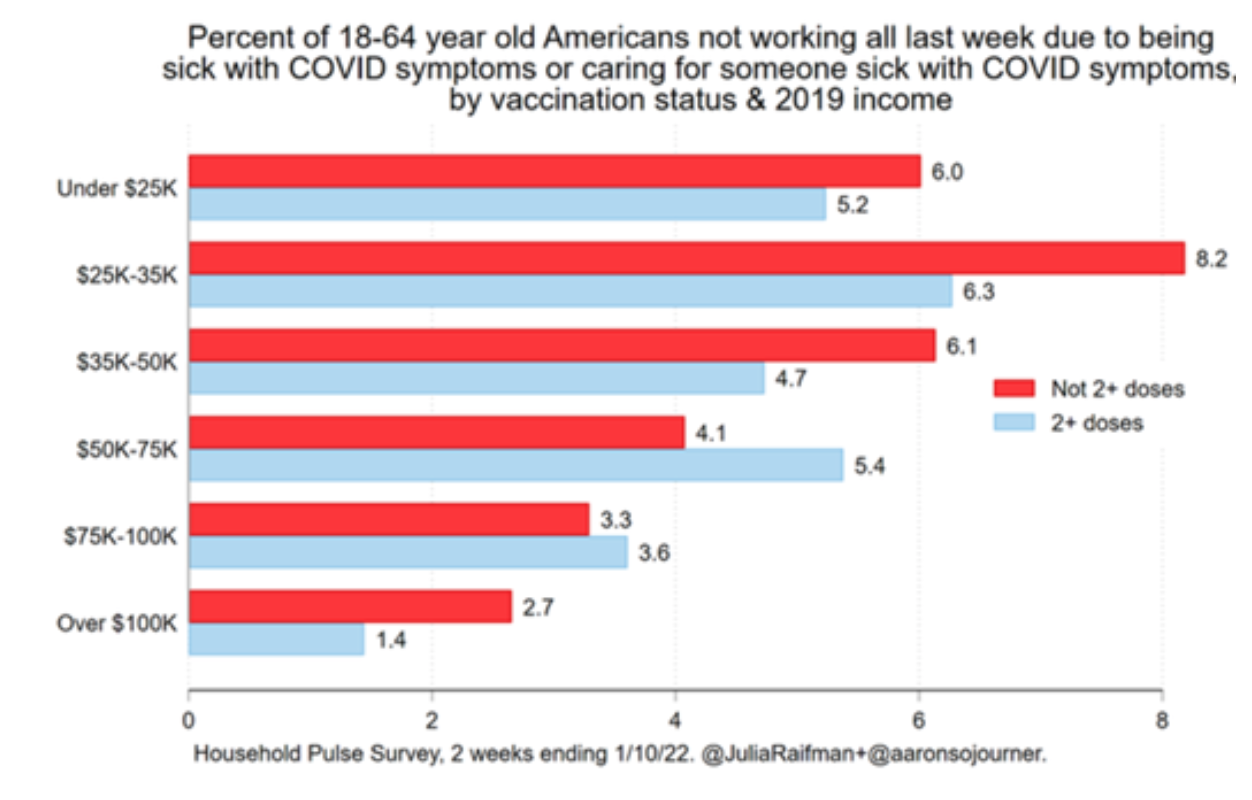[ad_1]
An important Economic Policy Institute article (hat tip martha r) confirms what many had suspected: that Covid was hurting lower income workers the most. We’ll shortly go through its analysis, which is important and informative. We will also review its recommendations, which are more of a mixed bag. Mind you, we don’t mean to come down on EPI, which is not a public health or bioscience site. But EPI’s stance sadly reflects that a lot of analysts haven’t gotten the memo about how poor our Covid choices are, given that the officialdom has rejected containment and even Japan-level approaches of aggressive masking and attention to indoor air quality.
Mind you, this report shows yet more ways that Covid is widening inequality. We already had a big dose in how the economic support programs were carried out. In the US, the PPP loans, for businesses, nominally to preserve payrolls, were the biggest program. Supplemental unemployment was the biggest form of income support…which bypassed the elderly, many casual workers, those who’d dropped out of the workforce, and was often very very late to arrive (California and Alabama were both laggards). Even the World Economic Forum took note in 2020, because too much inequality is bad for commerce:
There are at least four ways the COVID-19 pandemic is increasing inequality:
• First, higher-paid workers are working from home while lower-paid blue-collar workers typically do not have this option.
• Second, a higher share of low-paid workers are in essential services such as nursing, policing, teaching, cleaning, refuse removal, and store attendants where they are more likely to come into contact with people who are infected.
• Third, lower paid workers are more represented in the sectors that have suspended activities such as hotels, restaurants and tourism services.
• Fourth, the pandemic is increasing poverty and inequality between richer countries that can afford to bail out their firms and provide social safety nets, and poorer countries that do not have the capacity to do so…..The pandemic is a boon for the ultra-rich. The staggering rise in the stock-market is testament to this. In the US, over 44 million people lost their jobs and unemployment surged towards 15% between April and June 2020. Yet the fortunes of the top five billionaires rose by $102 billion, increasing their wealth by 26%. In fact, the combined wealth of US billionaires increased by over $637 billion to a total of $3.6 trillion, which is considerably more than the entire wealth of the 54 countries on the African continent.
And echoing the old economists’ joke: “It’s true in practice, but it is true in theory?” Based on the performance of past pandemics, economists anticipated that this one would also increase inequality. Apparently it takes a Black Death level labor wipeout to fundamentally restructure labor relations. From VoxEU in May 2020:
While there is much to be learnt from the experience of pandemics that occurred prior to this century – see Barro et al. (2020) on the Spanish flu of 1918-19 and Jordà et al. (2020) for even earlier events – our present analysis focuses on five major epidemics of this century – SARS (2003), H1N1 (2009), MERS (2012), Ebola (2014) and Zika (2016) – which each affected several countries….
Figure 1 shows the estimated impulse response of the net Gini to a pandemic event over the five-year period following the event. Pandemics lead to a persistent and significant increase in the net Gini measure of inequality. After five years, the Gini is above its pre-shock level by about 1.25%….
Figure 1 Impact of pandemics on inequality
We find that the impact on the net Gini is larger than that on the market Gini, which suggests that policies undertaken to address previous pandemics may have ended up having regressive effects. While further investigation of this result is needed, it is worth noting that early assessments of some government programmes enacted to combat COVID-19 suggest that the rich are the major beneficiaries
Now to the EPI paper. It presents some routes by which low-income workers are hit hard by Covid, in particularly due to directly missing more days of work than well-paid workers, due both to having been sick and to having to care for sick family members. The affluent can take sick days, make up for missed time on the weekend, or just get cut slack (who can tell how many hours you are putting in if you aren’t on Zoom or monitored all day?). And high income workers are more likely to have nannies or be able to hire help if really needed.
Key points:
Among working-aged Americans, those with 2019 household incomes less than $25,000 were 3.5 times as likely to report missing an entire week of work mainly due to their own or loved ones’ COVID-19 symptoms, relative to those earning $100,000 or more….
When low-income workers miss work due to COVID-19, they not only face the risk of severe illness—their families also report not being able to afford enough food to eat. After the expiration of the federal sick leave program, few low-income workers have access to paid sick leave to support them in self-isolating while infectious, reducing viral spread in the community, and leading a healthy recovery. Only 35% of low-wage workers have paid sick leave while 95% of high-wage workers do.
This is all very helpful, but then the report reaches conclusions that don’t clearly come from its data. For instance:
This chart does not prove that the problem of lower vaccination levels among lower income workers is a matter of access. It does clearly show that vax hesitancy/resistance is correlated with income. By not getting more information about the “would/would consider” group, it is unclear how much of the impediment is “access” versus uncertainty.1
Admittedly the plural of anecdote is not data, but none of my mother’s aides who were CNAs were vaccinated (they accepted a strict making regime, including not eating or drinking near her). And they did not have access issues. One had had Covid in the last six months and didn’t deem it necessary (yet). The others were not willing to risk a vaccine reaction forcing them to miss a day or two of work.
And I must say but this chart is not terribly informative:
Look at the time period.
The incubation period for Omicron averages three days.
White collar workers typically do not go to the office at all from Christmas to just after New Year, which this year would have been December 23 to Jan 3. Moreover, at least in big cities like New York, there was a huge scare about Omicron infections from holiday parties in the first and second week in December, so many had either already gotten sick or were being newly cautious.
Even allowing for non-vaccine income factors, this chart says absolutely nothing about the wage earners themselves because it conflates their outcomes (did they get sick or not) with caregiving for others (children in particularly; babies and under 10 years olds were very vulnerable) and the elderly. Not only do elder care burdens fall largely if not entirely on family members, since they can’t afford to hire help, lower income families are also more likely to have seniors in poor health (lifetime lower access to health care, higher probability of having diabetes and/or a poor diet; higher odds of having been in workplaces that imposed a health cost).
In other words, it is distressing to see EPI either captured by the conventional narrative or unwilling to qualify its analysis and suggest it might make sense to ask additional questions to get more definitive answers.
And as you get further into the article, you can see how it reflects the inability of the policy elites to accept the very bad hand they’ve deal themselves with respect to Covid. This article clings to the notion that getting boosted is protected when, as GM has pointed out, by ten weeks, efficacy against bad outcomes has fallen below 50%, which is too low if de novo for the vaccine to have been approved. Getting boosted 3-4 times a year is not a viable option even if the US could manage it operationally; the European Medical authority has advised against it as too likely to overtax the immune system.
So with the current vaccines, no one will be well vaccinated against Covid going forward unless they put their immune system at risk. Some may be robust enough for that to be a good tradeoff, but there’s no guidance as to what reasonable proxies might be. For instance: what should people with autoimmune diseases or a history of autoimmune diseases in their families do?
And as we keep stressing, the point of getting immunized, particularly with Omicron being so highly infectious and largely escaping the current vaccines, is to protect yourself from bad outcomes and on a societal level, to reduce strain on the medical system. And it’s not clear that that is true under Omicron:
Israel reports 80% of hospitalizations are vaxxed. Saskatchewan reports 80%, too. UK data reports 80% of COVID deaths are vaxxed. Cases are proportional to deaths as per Farr’s Law in 3 different countries. We can expect the same is occurring everywhere. pic.twitter.com/dzvyFXUL2I
— Matthew McBride, MPH MSHI, Health Policy Expert (@healthpoltruth) February 6, 2022
The authorities and press have kept acting as if getting vaccinated protects others. With Omicron and these vaccines, the answer is somewhere between “barely” to “not at all”.
And even worse, the vaccine fixation has helped stymie policies that would help reduce contagion, the most important of which is to have people who have gotten Covid to isolate for ten days or at least 2 days of negative at home Covid tests.
Now that means we are back to what this site has long advocated, independent of vaccines: engaging in full bore non-pharmaceutical interventions, particularly masking and ventilation. We also said from early on that the way out would require good treatments, but with the FDA having approved Merck’s molnupiravir, which has low efficacy and good potential to breed hardier variants, we are going down the wrong track there too.
So one can read the EPI recommendations either as disconnected from the state of play, or a highly coded statement that they know the emperor has no clothes. For instance:
To inform an equitable policy response, the government needs comprehensive data on all Americans and communities most at risk. Policymakers, the Supreme Court, and researchers may use COVID-19 surveillance data on occupations with high exposure to COVID-19 to help provide further information about the virus and how to respond most effectively.
Huh? The data in the US has been terrible and is getting worse all the time. Thanks to prevalent home testing, which both has a high rate of false negatives and does not have a mechanism for reporting, the US now has no idea how many Covid cases there are. The official numbers are low, but how low is anyone’s guess.
IM Doc also reports that in his highly vaxxed county, many of his patients (and he himself, despite concerted efforts to correct his own record) are incorrectly counted as unvaxxed, so that data is corrupt too.2
Scientist GM has been sending sightings for months on how states are delaying or fudging their numbers. For instance, from a mid-January 2022 e-mail:
Reporting is already severely compromised.
It was bad already in 2020 — Florida was still reporting deaths that happened in May 2020 in October 2020.
But then last year Florida, and then Nevada, Missouri, and several others moved to reporting deaths by date (which meant that the curve always looks like it’s going down), the delays became even longer, most states stopped reporting on weekends, some moved to reporting once every few days, TN moved to reporting weekly (but with no data from the 3rd of January to the 19th this month), etc. etc.
That peak in September that is now at 2,020 deaths a day, i.e. just short of April 2020? Well, it was 1,500 or so on that date itself, the rest was added later, mostly by FL, but also MO, NV, and several others.
I would not be surprised if the actual number of people dying right now is close to 4,000 rather than the official 2,000, and I am ready to bet substantial money that it is above 3,000.
And more cheery news:
Israel ??
Director of the Infectious Diseases Unit at Sheba Hosp, Prof. Rahav:
“We have identified a phenomenon of omicron recoverers who deteriorate and reach a severe condition after about 10 days, with problems that are not necessarily related to the airways”
-Kann News
— Gabriel Hébert-Mild™ ? (@Gab_H_R) February 6, 2022
Contrast that to the thin gruel from EPI:
Vaccine mandates
Vaccine mandates are key to increasing the reach of vaccination as a tool for both reducing severe disease and limiting hospital overflows and economic and societal disruption. The Biden administration can work closely with governors and mayors to implement vaccine mandates for all workers and workplaces.
I cannot believe they wrote that. It discredits them. But there is more:
Data-driven mask policies
COVID-19 spreads through the air, and mask policies that help people mask together are one of the most effective policies for reducing the spread of COVID-19. Data-driven mask policies are linked to local transmission rates and can turn off when cases are low and can turn on when cases begin to surge. New variants are likely, and having mask policies that automatically turn on could be especially important for more lethal or vaccine-evading variants.
That horse left the barn in May 2021 when the Biden Administration confirmed the conservative “masks as oppression” position by depicting going unmasked as a reward and a sign of vaccinated virtue. It’s hard enough to get people to mask up. The flip side is that many examples, from the Creel Committee onward, have shown that full bore multi-channel propaganda campaigns (including using churches and social groups) can change public opinion massively in 6 weeks to two months. But this Administration prefers to use the deplorables as their excuse for Covid failure rather than try to reach them (which would also require listening to understand where they are coming from rather than scolding them).
The post does pump for more high quality masks, more access to tests, and paid leave for low income workers. But there is nary a mention of ventilation.
I suspect that EPI is so dependent on mainstream Democrat funding sources that it can’t stray from the party line. But reading these policies evokes the sort of images that Lambert and I discuss often, of people in charge, sitting in a car, turning wheels and hitting controls that they thing are doing something but in fact aren’t connected to anything.
And they weirdly don’t perceive that they are going nowhere.
_____
1 Not having seen the survey instrument, you may also be seeing “shy Trump voter” behavior, that some of the “would considers” may actually be in pleasing the interviewer mode.
2 It might be pretty accurate in CA and certainly is in the VA system.
[ad_2]
Source link












